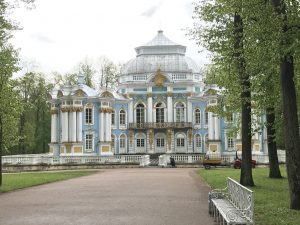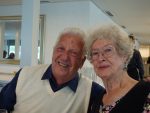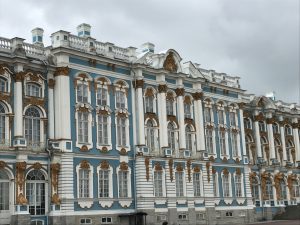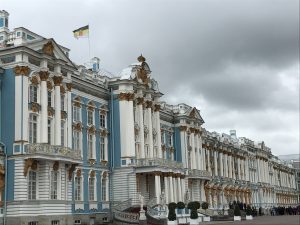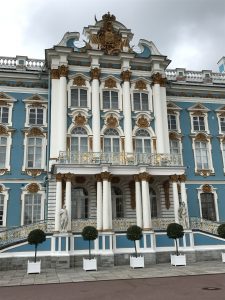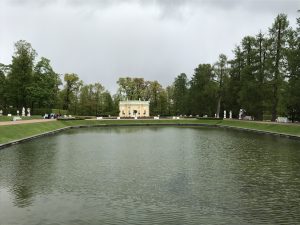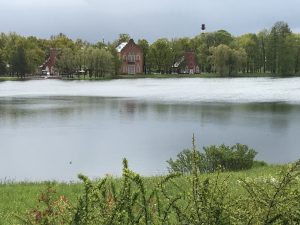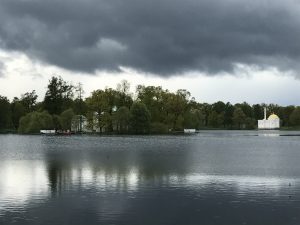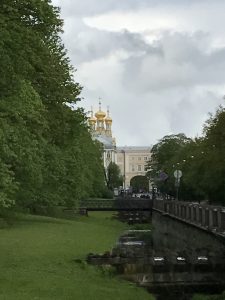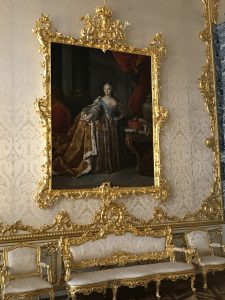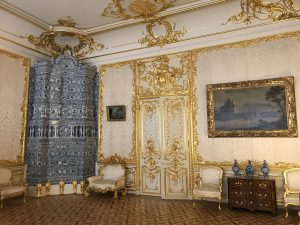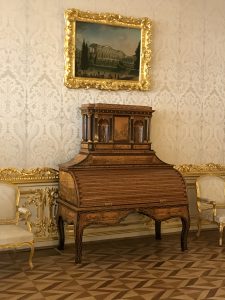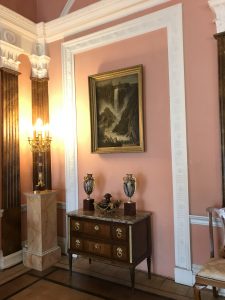Imperial Waterways of Russia
The Catherine Palace
First, a reminder: This is one of three pages describing our time in St. Petersburg. The other two:
St. Petersburg
The Winter Palace
June 3 started out a bit rainy, and that didn’t make it easy getting an early start for the town of Pushkin, site of the Catherine Palace. The extravagant palace was built early in the eighteenth-century for Catherine I, not Catherine the Great, although the latter certainly inhabited this “summer palace” later in the century. That’s one of those little tidbits that helped to explain the wide range of styles we saw inside the place. But–I get ahead of myself.
 The buses let us off near the palace gates, but even so our walk through the carriage courtyard to the entrance wasn’t a short one. Two things made that walk less onerous than it might have been, in spite of the intermittent drizzle. One was the sight of the chapel domes, shining even through the rainfall. The other was seeing two groups of costumed brass players, one outside the gate, one next to the entrance. What a great idea! In a situation where people had to stand in line, sometimes for quite a while, provide entertainment! And they were indeed entertaining. We were once again being admitted before the place was open to the general public, so our wait wasn’t long enough to catch an entire tune, but it was still fun to hear them. And to watch them.
The buses let us off near the palace gates, but even so our walk through the carriage courtyard to the entrance wasn’t a short one. Two things made that walk less onerous than it might have been, in spite of the intermittent drizzle. One was the sight of the chapel domes, shining even through the rainfall. The other was seeing two groups of costumed brass players, one outside the gate, one next to the entrance. What a great idea! In a situation where people had to stand in line, sometimes for quite a while, provide entertainment! And they were indeed entertaining. We were once again being admitted before the place was open to the general public, so our wait wasn’t long enough to catch an entire tune, but it was still fun to hear them. And to watch them.
We went through the same routine we had the day before, stowing rain gear in the cloak rooms and then going through a somewhat less intense security process. This time there was a new wrinkle: we all had to wear little plastic booties over our shoes, in order to protect the original floors, many of which were inlaid with delicate woodwork. Picture it: a hundred or so senior citizens in a small room, trying not to fall down as they struggled to open and don freshly unpacked one-size-fits-all plastic booties over shoes they had chosen to wear because they were large and sturdy enough to keep the cold rain off their feet. And seating was in short supply, so some people were sitting on one of those fine hardwood floors in the middle of the room. In retrospect, I do wish I had pulled out my trusty phone and made a few videos, though doing so might have been a suicidal move. I’ll just have to be content to let the memory alone amuse me.
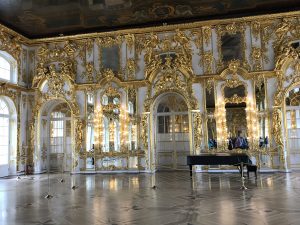 That part of the fun didn’t last as long as it might have, at least, and we all trundled out of the tiny little room to begin the tour. Once again, we began by ascending an Imperial Staircase and entered the first of many highly elaborate late Baroque rooms. The ballroom, reminiscent of Versailles’ Hall of Mirrors is truly grand, and it was sort of fun to see a grand piano there at one end. From there we went through a series of rooms that had not only been restored but had also been furnished with period items: painting, sculpture, tables, chairs, occasional pieces, and even tableware. Although I don’t always appreciate such items in other contexts, I really enjoyed seeing them in this context.
That part of the fun didn’t last as long as it might have, at least, and we all trundled out of the tiny little room to begin the tour. Once again, we began by ascending an Imperial Staircase and entered the first of many highly elaborate late Baroque rooms. The ballroom, reminiscent of Versailles’ Hall of Mirrors is truly grand, and it was sort of fun to see a grand piano there at one end. From there we went through a series of rooms that had not only been restored but had also been furnished with period items: painting, sculpture, tables, chairs, occasional pieces, and even tableware. Although I don’t always appreciate such items in other contexts, I really enjoyed seeing them in this context.
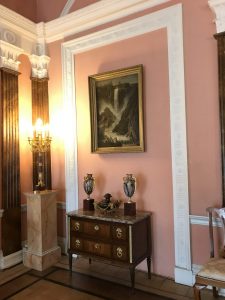 Although Judy and I both managed to photograph a lot of these rooms, two of them deserve some comment. One of those is the celebrated “Amber Room,” of course. I must admit, it’s beautiful, but more of a curiosity than something I would want to live with. I’m glad I’ve seen it, and I regret not having any photographs. In fact that was the only room on the tour where we were not allowed to take photographs, but if I had thought about it soon enough, I could have gotten a few shots from just outside the doorway. I did take as much time as the guide’s schedule allowed to study some of the walls more closely. It’s a recreation of the original, which disappeared at the end of WWII, and truly amazing, and I had never realized how many shades of yellow/gold/red-gold/red amber actually existed. Well worth the time to see it, even for someone like me. The other notable rooms were the ones either built or redone later in the century. They were so beautifully clean in their line and decor, that it was like a vision of home, or a breath of fresh air. Again, that’s not my usual reaction to the Classical style of most buildings of the period I’ve seen, but after all the Baroque and Rococo froo-froo and gold, it hit me like an Andes mint after an over-rich meal. Clean. Refreshing. Nice.
Although Judy and I both managed to photograph a lot of these rooms, two of them deserve some comment. One of those is the celebrated “Amber Room,” of course. I must admit, it’s beautiful, but more of a curiosity than something I would want to live with. I’m glad I’ve seen it, and I regret not having any photographs. In fact that was the only room on the tour where we were not allowed to take photographs, but if I had thought about it soon enough, I could have gotten a few shots from just outside the doorway. I did take as much time as the guide’s schedule allowed to study some of the walls more closely. It’s a recreation of the original, which disappeared at the end of WWII, and truly amazing, and I had never realized how many shades of yellow/gold/red-gold/red amber actually existed. Well worth the time to see it, even for someone like me. The other notable rooms were the ones either built or redone later in the century. They were so beautifully clean in their line and decor, that it was like a vision of home, or a breath of fresh air. Again, that’s not my usual reaction to the Classical style of most buildings of the period I’ve seen, but after all the Baroque and Rococo froo-froo and gold, it hit me like an Andes mint after an over-rich meal. Clean. Refreshing. Nice.
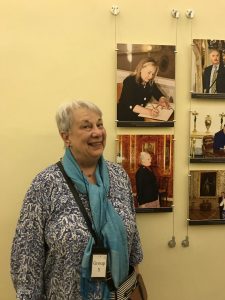 But wait, there’s more. Of course. We next trundled through some other rooms, down a few back stairs, and along a corridor lined with photographs. Some of them showed the state of the Catherine Palace in its decline after the Revolution and the fall of the monarchy. Some of them showed progress during the restoration process. And some of them showed more recent world visitors, including Hillary Clinton in her position of US Secretary of State. We did have to pause for that one. Eventually, we were allowed to discard the plastic booties and move into the pièce de réisistance, the Gift Shop.
But wait, there’s more. Of course. We next trundled through some other rooms, down a few back stairs, and along a corridor lined with photographs. Some of them showed the state of the Catherine Palace in its decline after the Revolution and the fall of the monarchy. Some of them showed progress during the restoration process. And some of them showed more recent world visitors, including Hillary Clinton in her position of US Secretary of State. We did have to pause for that one. Eventually, we were allowed to discard the plastic booties and move into the pièce de réisistance, the Gift Shop.
 Along with several other members of our group we had befriended, I waited outside while Judy, Cindy, and Jean shopped. All in all, Judy did her usual thing by shopping carefully, ignoring the ceramic organist and exiting the shop with a couple of really nice items.
Along with several other members of our group we had befriended, I waited outside while Judy, Cindy, and Jean shopped. All in all, Judy did her usual thing by shopping carefully, ignoring the ceramic organist and exiting the shop with a couple of really nice items.
The Gardens
After all of that, we retrieved the rain gear, left the main building and began a somewhat dampish walk through the gardens. Again, it was a lot like Versailles, but different. We could have walked through at least the exterior promenades of the Cameron Galleries, but the weather and our fatigue prevented that. On the other hand, just staying on the ground level we started on was a challenge in the drizzle that kept blowing in and out. The gardens weren’t quite so filled with color as they would be in a few weeks, but it was fun to see the trees in the formal gardens trimmed to look like lollipops.
It’s always fun to see formal gardens, and we walked past those, but it’s more interesting to see the other components that the aristocracy chose to include. In the Catherine Palace gardens, that includes a lake with buildings on the near side and glimpses of fascinating structures on the far side. We walked beside the lake to the pavilion, then through the carefully planted “natural” forest to see the local hermitage. If my memory serves, that building is now used for dinners and maybe even wedding celebrations. How cool is that?
People
Judy and I returned to the ship for lunch, passing on the opportunity to visit the Peterhof Gardens the rain. We enjoyed another session on Russian history, this one covering the end of the Monarchy, which involved more than a little murder and mayhem.
After that exciting hour, we enjoyed another dinner with our new friends from Seattle and Houston. While we were enjoying dinner, the ship actually “set sail,” though that’s not a literal description. The ship moved first south, then east, then northeast, moving along the Neva river. By the time we entered Lake Ladoga, Judy and I were well into deep sleep by then, but when we wake the next morning, we had crossed the lake and were into the next river: the Svir. Our next stop? Mandrogi. A planned craftsman/tourist village about halfway through that river on the way to the next lake.

